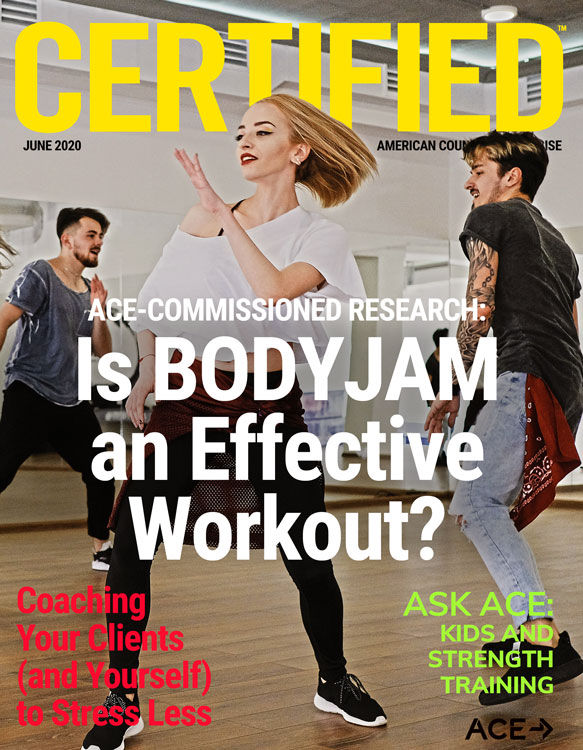
In this series, ACE experts answer your health and exercise questions. From nutrition to technology, you’ll find detailed answers to many of the questions that may come up in your work with clients. If you have questions you’d like to ask our experts, please email us at Christine.Ekeroth@acefitness.org.
The Expert:
 Avery D. Faigenbaum, EdD, FACSM, FNSCA is a Full Professor in the Department of Health and Exercise Science at The College of New Jersey. He is an internationally recognized leader in the field of pediatric exercise science, with a special emphasis on integrative neuromuscular training and preventive medicine. He has co-authored over 250 scholarly articles, 50 book chapters and 10 books, and has delivered more than 300 invited lectures in 12 countries. He is a Fellow of the National Strength and Conditioning Association and of the American College of Sports Medicine, and was awarded the 2017 Boyd Epley Award for Lifetime Achievement from the National Strength and Conditioning Association.
Avery D. Faigenbaum, EdD, FACSM, FNSCA is a Full Professor in the Department of Health and Exercise Science at The College of New Jersey. He is an internationally recognized leader in the field of pediatric exercise science, with a special emphasis on integrative neuromuscular training and preventive medicine. He has co-authored over 250 scholarly articles, 50 book chapters and 10 books, and has delivered more than 300 invited lectures in 12 countries. He is a Fellow of the National Strength and Conditioning Association and of the American College of Sports Medicine, and was awarded the 2017 Boyd Epley Award for Lifetime Achievement from the National Strength and Conditioning Association.
Q. One of my clients is the parent of an 8-year-old girl. He just enrolled her in a youth fitness class, but he is concerned that the program includes strength-building exercises. What can I do to educate him and other parents about the potential benefits of youth resistance training?
Girls and boys should participate in well-designed youth fitness classes that include strength-building exercises. A compelling body of scientific evidence underscores the safety and efficacy of youth resistance training and public health objectives now aim to increase participation in strength-building activities (United States Department of Health and Human Services, 2018; Lloyd et al., 2014). Even so, misperceptions associated with youth resistance training persist. Some parents may be concerned about the safety of youth resistance training and others may ask why strength-building exercises need to be part of youth fitness programs. As a health and exercise professional, it is important that you work to dispel outdated misperceptions associated with youth resistance training and educate parents about the potential benefits of well-designed resistance-training programs for children.
While a low level of muscular strength is a well-recognized risk factor for functional disability and adverse health outcomes in older adults, the same can be said for today’s youth, who appear to be weaker and slower than previous generations (Faigenbaum et al., 2019). Because a prerequisite level of muscular strength is needed to run, jump and kick proficiently, kids who are weaker may be less likely to engage in moderate-to-vigorous physical activity (MVPA) and more likely to suffer adverse health consequences. Inactive youth are at increased risk for musculoskeletal injuries, poor cardiometabolic health and suboptimal psychosocial well-being (Faigenbaum et al., 2020).
"The best available evidence shows today’s youth need to incorporate strength-building exercises into their fitness programs.”
Without regular opportunities to improve their muscular fitness (i.e., muscular strength, muscular power and local muscular endurance), today’s youth may lack competence and confidence in their physical abilities to participate regularly in active play, exercise and sport activities. Low levels of muscular strength and poor movement skills can interact synergistically to predispose youth to physical inactivity and consequent health risks. Without interventions that specifically target strength deficits early in life, weaker children may be ill-prepared to break through a so-called “strength barrier” that would allow them to perform fundamental movement skills proficiently (Faigenbaum et al., 2019). It is unlikely that today’s children will be able to attain an optimal level of muscular fitness and motor skill prowess without some type of structured fitness training that includes resistance exercise.
Resistance Exercise Is Medicine
“Resistance exercise has proven to be a polypill due to its unique anatomical, physiological and psychological benefits for children and adults,” says Wayne Westcott, PhD, professor of exercise science at Quincy College in Massachusetts. With qualified instruction, technique-driven progression and a safe exercise environment, regular participation in strength-building activities can do much more than increase muscular fitness. Youth resistance training can increase motor-skill performance, enhance bone strength, facilitate weight control, improve cardiometabolic health and boost performance in exercise and sport activities (Lloyd et al., 2014). Moreover, there is a growing evidence for a positive association between muscular fitness and physical activity (particularly vigorous physical activity) in youth (Smith et al., 2019), and resistance training appears to have a protective effect on sport-related injuries (Lauersen, Andersen and Andersen, 2018). Additionally, stronger young athletes seem to be better prepared for the game and less likely to suffer a sports-related injury.
Parents need to be informed about the unique health- and fitness-related benefits of youth resistance training. “The best available evidence shows today’s youth need to incorporate strength-building exercises into their fitness programs,” says Dr. Westcott, who has researched the effects of resistance training on children for the past 40 years.
The Potential Benefits of Youth Resistance Training

Because many habits established early in life tend to track or carry over into adulthood, childhood is an ideal time to expose girls and boys to a variety of exercise and sport activities. With instruction and encouragement from health and exercise professionals, weaker children can gain confidence and competence in their abilities to perform strength-building exercises and, in turn, begin to move proficiently in a variety of physical activities in different settings. Over time, children may begin to enhance their physical literacy, which is foundational to ongoing participation in MVPA throughout the course of their lives (Zwolski, Quatman-Yates and Paterno, 2017). Physically literate children enjoy participating in different physical activities and are more likely to achieve the recommended amount of MVPA. Additionally, physically literate children typically value human movement, understand the importance of physical activity and help others acquire the necessary skills and behaviors that support an active lifestyle. This concept underscores the importance of integrating different exercise activities—including resistance training—into youth fitness programs.
Right From the Start
As a health and exercise professional, you are in an ideal position to design and implement youth fitness programs that target strength deficits and build strength reserves early in life. With effective teaching strategies and ongoing instruction, young children can learn strength-building exercises with animal-like movements such as bunny hops and bear crawls. Resistance training with medicine balls, elastic bands, free weights and weight machines can also be incorporated into youth fitness programs (Faigenbaum and Westcott, 2009). The key is to recognize muscular strength as foundational to youth physical fitness and design interventions that are consistent with each participant’s needs, goals and abilities. Although there is no minimum age requirement for participation in strength-building activities, most 6- and 7-year-old children are ready for some type of supervised resistance training that is developmentally appropriate.
Fostering relationships, promoting healthy behaviors and focusing on exercise technique will help reinforce important goals of youth resistance training. This is where the art and science of designing youth fitness programs come into play, as the fundamental principles of resistance training need to be balanced with effective teaching and positive experiences. All too often, contemporary thinking related to youth fitness focuses on time spent performing MVPA and neglects the critical importance of having fun, making friends and learning something new. Troubling trends in youth physical inactivity call for a new approach for activating inactive children with fitness programming that targets strength deficits before youth become resistant to exercise interventions later in life.
Without prerequisite levels of muscular strength, it is unlikely that children will optimize gains in other important components of physical fitness. New insights into the design of long-term athletic development programs highlight the critical importance of building a strong foundation right from the start (Faigenbaum et al., 2020). Health and exercise professionals should use the best available scientific evidence to educate parents about the safety and efficacy of youth resistance training while raising awareness about the unique health- and fitness-related benefits of youth resistance training. Given the cascade of adverse health outcomes associated with muscle weakness, health and exercise professionals should integrate strength-building exercises into youth fitness programs to prepare girls and boys for a lifetime of physical activity.
References
Faigenbaum, A. et al. (2020). Essentials of Youth Fitness. Champaign, Ill.: Human Kinetics.
Faigenbaum, A. et al. (2019). Resistance exercise for the prevention and treatment of pediatric dynapenia. Journal of Science in Sport and Exercise, 1, 3, 208−216.
Faigenbaum, A. and Westcott, W. (2009). Youth Strength Training. Champaign, Ill.: Human Kinetics.
Lauersen, J., Andersen, T. and Andersen, L. (2018). Strength training as superior, dose-dependent and safe prevention of acute and overuse sports injuries: A systematic review, qualitative analysis and meta-analysis. British Journal of Sports Medicine, 52, 24, 1557−1563.
Lloyd, R. et al. (2014). Position statement on youth resistance training: The 2014 International Consensus. British Journal of Sports Medicine, 48, 7, 498−505.
Smith, J. et al. (2019). Behavioral correlates of muscular fitness in children and adolescents: A systematic review. Sports Medicine, 49, 6, 887−904.
United States Department of Health and Human Services. (2018). Physical Activity Guidelines for Americans (2nd ed.). Washington, D.C.: Department of Health and Human Services.
Zwolski, C., Quatman-Yates, C. and Paterno, M. (2017). Resistance training in youth: Laying the foundation for injury prevention and physical literacy. Sports Health, 9, 5, 436−443.





 by
by 

 Avery D. Faigenbaum, EdD, FACSM, FNSCA is a Full Professor in the Department of Health and Exercise Science at The College of New Jersey. He is an internationally recognized leader in the field of pediatric exercise science, with a special emphasis on integrative neuromuscular training and preventive medicine. He has co-authored over 250 scholarly articles, 50 book chapters and 10 books, and has delivered more than 300 invited lectures in 12 countries. He is a Fellow of the National Strength and Conditioning Association and of the American College of Sports Medicine, and was awarded the 2017 Boyd Epley Award for Lifetime Achievement from the National Strength and Conditioning Association.
Avery D. Faigenbaum, EdD, FACSM, FNSCA is a Full Professor in the Department of Health and Exercise Science at The College of New Jersey. He is an internationally recognized leader in the field of pediatric exercise science, with a special emphasis on integrative neuromuscular training and preventive medicine. He has co-authored over 250 scholarly articles, 50 book chapters and 10 books, and has delivered more than 300 invited lectures in 12 countries. He is a Fellow of the National Strength and Conditioning Association and of the American College of Sports Medicine, and was awarded the 2017 Boyd Epley Award for Lifetime Achievement from the National Strength and Conditioning Association.
